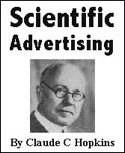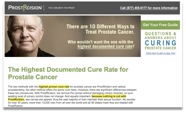This is a guest post by Charles Lumpkin, the principal of Charles Lumpkin + Partners. Charles and his firm have been entrusted with million dollar budgets by
companies who demand disciplined and measurable Internet
marketing. He and his team provide Internet marketing strategy and
services, usually on a pay-for-performance basis to companies of all
sizes. Charles is a sponsor of FoG.
Let me offer some advice. If you want your business to survive – know these two things; how much a customer is worth to you and how much you can afford to get one. As you go about your marketing efforts, measurement is key.
Find out your CPA (Cost Per Acquisition)
Without a doubt the most important questions that you must answer are the rate and cost of customer acquisition for your business. You get this wrong, and you are toast. I know of no more efficient way to fold up shop. As a startup you’ve got to figure out (and quickly) how much it will cost you to bring on new customers.
So, fearless leader, you’ve got to put your marketing plan to a test as soon as you possibly can; driving toward measuring and reducing that all important CPA. If you need help with this calculation contact me and we can walk through it for your company. Regardless, take the time to determine your CPA as soon as you can.
Start ratcheting that thing down
Now that you know the number your job 
So science, really? No, seriously, every time you run an ad you should be running a controlled experiment. Take your best effort to date and create at least one variation of it. Test them head to head, and then retest them. The winner becomes your new “Control”. And you never stop. That’s right, as long as you are running your business; there is no rest for the weary. Innovate or perish!
Different Media – Same Methods
The wisdom put forth in this old tome, is applied to the media that were popular in the day, primarily print. Believe it or not, these are the same principals the best and the brightest follow to this day in online marketing. Follow Claude’s advice and you will find that your will soon be getting way more bang for your online advertising buck.
There’s no school like old school
In the old days they tracked advertising with printed source codes on coupons, in mailers and catalogs. When you ordered your item, advertisers knew which ad drove the sale. Pretty neat stuff right? Now this is akin to running a Google ad and watching what conversion activity happens in your analytics package. You might vary the copy and determine which ad pulls more and you are running an experiment.
The Split Test
The simplest form of a scientific test is the split test. Split your audience using a random or controlled sampling method, serve up variations of your ad to the samples and compare your results.
From Scientific Advertising:
One ad is compared with another, one method with another. Headlines, settings, sizes, arguments and pictures are compared. To reduce the cost of results even one percent means much ….. So no guesswork is permitted. One must know what is best. Thus mail order advertising first established many of our basic laws.
Here’s a sample of variations of two versions of landing page split test:
Which wins? Test it and find out!
The More Things Change the More they Stay the Same
The media may change, measurement tools may change, but the benefit of applying solid methodology and disciple to testing, recording and sharing results is a concept that can’t be emphasized enough. Although Hopkins suggests that his contemporaries had started to get it right. I can’t help but see ourselves in these words:
The lack of those fundamentals has been the main trouble with advertising of the past. Each worker was a law to himself. All previous knowledge, all progress in the line, was a closed book to him. It was like a man trying to build a modern locomotive without first ascertaining what others had done. It was like a Columbus starting out to find an undiscovered land.
Does this sound a little like some forays into banner advertising and social media? As we rush to keep up with the technology and be everywhere at once, how well are we measuring the impact of our efforts?
A/B testing, hold-out panels, test markets are not new ideas, they are simply under utilized. A good refresher course can be found in this 87 year old book. Apply the concepts to new media, drive your CPA down and watch your profits grow.
Wrap Up
Yes we spend time updating dashboards and reviewing reports, but are we really analyzing their implications and re-crafting our communications based on them? Are we testing one ad against another? From my exposure to many companies we are not. The simple truth is that as we work to build our businesses, whether well established or still on the drawing board, the principles espoused in this book can help us minimize risk, read and leverage successes and build business plans that have a high likelihood of becoming reality.
We don’t need to set a marketing budget and guess at results. Small tests can provide the data to predict the out-come off strategies that can then be rolled out. So why not adopt the methods that will help you sleep better at night, methods that mean your business investments will carry “so little risk”. Per Claude:
Advertising, once a gamble, has thus become, under able direction, one of the safest business ventures. Certainly no other enterprise with comparable possibilities need involve so little risk.
So get crackin’. Find out your CPA and start hammering it down. Apply the principals you learn in Scientific Advertising and go kick some ass.
You can read and download Scientific Advertising in its entirety below.



